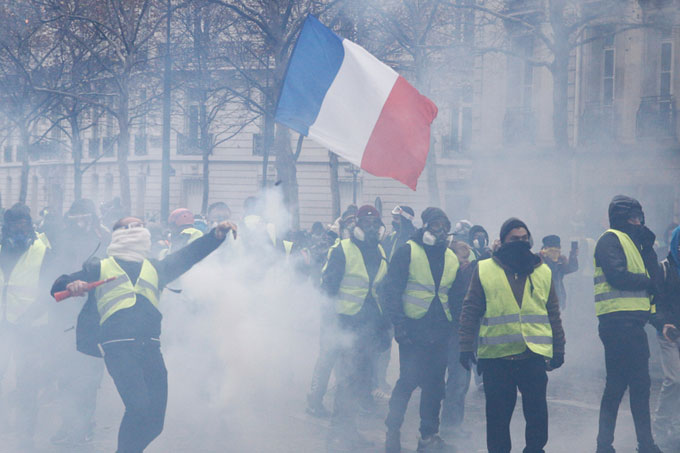Max Stafford looks at how recent protests in France could impact upon the French Presidency.
Every major protest has its key image. The 2011 London Riots had a burning carpet store followed by Boris Johnson holding a broom aloft. The 2017 Women’s March, following Donald Trump’s inauguration, had the pink “Pussy Hat”. The recent French protests have, however, found their image in their very name.
The Gilet Jaunes protests (named after the “yellow vests” that French drivers are required to carry in their cars) began in November over proposed hikes to fuel taxes. Those tax increases have since been reversed but the protests have grown, becoming an urban protest movement which is now focused upon calls for President Emmanuel Macron to resign. The violence and length of the protests (which have lasted for two months and seen police using water-cannon, tear gas and rubber bullets) have gained them international attention. Indeed, last month The Guardian noted that copycat protests have now emerged from ‘Brussels to Basra’. It is, however, the French protests that continue to pose the greatest threat to their national leader.
Macron’s association with the protests is deep-rooted. Since his victory in 2017’s presidential election, Macron has sought to drive through a range of controversial reforms. These have been focused upon increasing France’s competitiveness and Macron has overtly stated that his reforms – centred upon employment rights and taxation – are intended to be pro-business and that the benefits may not be apparent for several years. This has brought the largest number of business start-ups since records began and cuts to corporation tax rates.
Youth employment has also received attention and is now at its lowest level in a decade, with a pilot of a scheme to reintroduce National Service due later this year. However, these measures are to be set against the contextual background of social security cuts and pre-Gilet Jaunes fuel tax rises (to pay for corporate tax cuts) and rising inflation. Together, these have fed a narrative suggesting that Macron must now urgently address a continued squeeze on household spending if he is to stand a chance of winning re-election in 2022.
So, the recent protests are not only rooted in issues surrounding Macron’s governance so far but, similarly, threaten to cast a shadow over the remaining three years of his presidential term. The question now is “What will become the symbol of Macron’s response?”
So far, the media has reflected the imagery of water-cannon and rubber bullets. However, the president is currently seeking to put himself back on the front foot by initiating a grand debat (“great debate”) across the nation. This is a risky strategy. On the one hand, it acknowledges the reality of the president having been placed at the centre of the maelstrom and, rather than attempting to shy away from that, seeks to make Macron appear as though he is moving from a more confrontational approach towards one that legitimises the populace’s concerns by listening. On the other hand, the strategy has been in evidence since the turn of the New Year, with Macron on a national speaking tour, but the protests have continued throughout January.
In short, it is too soon to say what the long-term impact of either the Gilet Jaunes or grand debat will be. The next presidential election is three years away and it seems unlikely that this particular set of protests will continue. However, Macron has so far failed to restore order to France’s streets and has moved from punching back to at least putting some velvet on the glove first. The French presidency is a powerful one and gives substantial executive power to its incumbent. That may all count for naught, though, if the people continue to refuse to listen.
Max Stafford is studying for a PhD in political leadership in Politics and International Relations.
 Expert comment
Expert comment Jeanette Earl
Jeanette Earl 1426
1426


